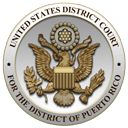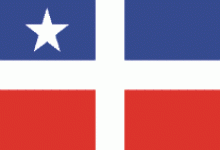|
Puerto Rico Flag < The Flag of the Maritime Province 1845-1898 (Steenbergen Book) |
This is the "Grito de Lares" flag, used 23 September 1868 during an unsuccessful uprising in Puerto Rico against the Spanish government. The flag is still preserved at the University of Puerto Rico. Even though all written material speaks of the star as white, some who have studied the flag up close have claimed that the star is unmistakably pale yellow. The Grito de Lares flag, intended to become the national flag of the Republic, was designed by Dr. Ramón Emeterio Betances and embroidered by Mariana Bracetti. Its layout honors their liaison to the Antillean Confederacy and nationalist forces in the Dominican Republic, where Dr. Betances was exiled. A Cry for Modernity or a Defense of Tradition? Translation by Janis Palma Many historians have wanted to see a liberal and What is known as El Grito de Lares [The Lares Uprising] should have been El Grito de Camuy [The Camuy Uprising]. The Spanish authorities learned about the matter and, faced with imminent retaliation, the Junta Revolucionaria [Revolutionary Board] moved up the date for the Lares pronouncement. Every year historians look for something new to add to what is already known about the Lares Uprising. Although we have the excellent work produced by Olga Jiménez, Ricardo Camuñas, Francisco Moscoso, Félix Ojeda, Luis de la Rosa, Laird Bergad, Lidio Cruz-Monclova, and many others who have delved into one aspect or another of the year 1868 in Puerto Rico, there is always someone who finds new data to contribute. The discussion as to the causes for the Lares Uprising is also enriched with the passage of time. Thanks to Gervasio García and other scholars during the 50s and 60s who explored the strictly political causes for the Uprising, scholars in the 70s and 80s probed into the economic roots and social conflicts in Puerto Rico during 1867-68. One must wonder if the discussion warrants expansion as we enter the 21st Century. As with all important events in history, the Lares Uprising has been built up and positioned so as to promote and satisfy the need for a core narrative that buttresses the collective persona. Hence the anxiety and impatience among those self-proclaimed custodians of that collective persona when someone seemingly disturbs the foundational narrative. When the economic and social historians of the 70s placed the Lares Uprising within the context of the severe economic contraction and fiscal crisis of 1867-68, there was no shortage of voices expressing alarm at the possible irreverence of explaining the Lares Uprising as a function of indebtedness, aggressive fiscal actions taken by the state, and conflicts between farmers and business owners. In time, the economic contextualization ceased to pose a threat and became part of the foundational narrative. The interesting thing is that, although the Lares Uprising could have taken place in Camuy, or maybe Mayagüez, or some other western municipality, the obsession has been to scrutinize Lares and forget about the rest of the Island. Sometimes the discourse is about a national revolution, but it is studied as a municipal phenomenon. All the abuse by the Spanish government and the outrage it caused are minimized, except for those in which Lares is involved; all acts of confrontation and resistance against that authoritarian government taking place throughout the rest of the Island become obscured, while the ones by the future protagonists of Lares become highlighted. El Grito de Lares has been selectively constructed with the men (and a single woman) of Lares. The repression by the Spanish government did not target the Lares population alone. It spread throughout the whole Island, precisely because the uprising was perceived as more than a mere local episode. It was the expression of an ample resistance encompassing all sectors of society. During the Constitutional 3-year period between 1870 and 1873 any dissidence or liberal movement was treated as a sequel to the Lares Uprising. After 1868 the Spanish government in Puerto Rico redoubled its vigilance and repression throughout the Island. This outrageous policy was derived not just from the memory of Lares but also from the continuing war in Cuba. The hostility of many Puerto Ricans towards Spain in 1898 cannot be understood if those three preceding decades of intimidation are not explored. When the Grito de Lares was memorialized during the 1930s as a core event for the Puerto Rican nation, the struggles against Spain had been forgotten, and the tendency was to evoke Spain as a counterpoint to the United States regime. The idealization of the times under Spanish rule led some people to say that the Lares uprising against Spain had only been a matter of principle, because we had come of age, but there was no profound contentious cause against the mother from whom we sought to emancipate. This interesting coming of age image has not disappeared from the political preachings and perhaps someone should spend some time tracing back its genealogy. In the meantime, it would be helpful to explore another possible source for the discussion about the accumulation of causes that have been proposed for the Lares Uprising. Curiously enough, given that the end of slavery was proclaimed in Lares, as was the end of the Libreta de Jornaleros [day laborer's wage logbook], and because the Betances Ten Commandments were identified with the Lares Uprising, many historians have wanted to see a liberal and modernizing ideology behind the concretion of the Uprising. The fact that Betances and others fighting for independence held this ideology does not necessarily mean that all the farmers and laborers who participated in the uprising had adopted it. Would it not be possible to think that a Spanish state that rationalized fiscal affairs, fostered commercial agriculture, was modernizing, secularizing, displacing elite land owners and their traditional clientele, may have led to a conservative reaction from the farmers and laborers? That the Motherland put on a pedestal in contraposition to the 19th-Century state may have been the motherland of the elders, the traditional world of the forefathers? Why is the vanguard for the revolutionary movement in the West and not the South? Where is Ponce to be found in Lares? Why is it that the most economically developed municipalities have such waned participation as compared to Camuy or Lares? And would that not be precisely the reason why, during the 1930s, those fighting the American regime, so perturbing in its modernizing projects, pose the Lares Uprising as the paradigm and central moment in our history? A Te Deum was held in Lares (which gave the militiamen in Pepino time to gear up) and the accounting books of local stores were burned. To evoke those images together may seem irreverent if the premise is the historical essentialism that refuses to examine the past that everyone has agreed upon. But to try to juxtapose them could perhaps help us confront the Puerto Rican paradox: the alternatives offered by those who put up the biggest fight against metropolitan domination and pillaging projects are oftentimes no more than moral motivations and guesswork about the past. |

